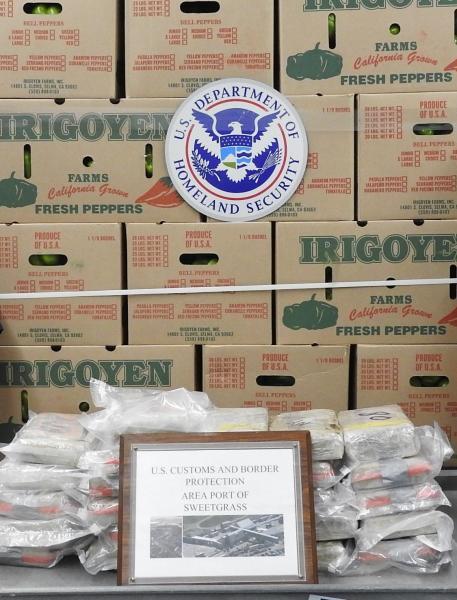Woman caught with cocaine in truck at border
A Canadian female truck driver was caught trying to smuggle a significant quality of cocaine into the country, U.S. border agents reported.
The suspect, who was driving a commercial truck loaded with watermelons and peppers destined for Canada, attempted to cross the border at Sweetgrass, Mont., on July 29.

U.S. Customs and Border Protection (CBP) officers referred the truck for further inspection.
During an in-depth inspection of the truck and trailer, CBP officers discovered bags concealed within the cargo. These bags contained a substance which tested positive for cocaine. The officers seized 69.5 pounds (31.5 kg) of cocaine.
“Utilizing high-tech tools, our frontline CBP Officers used a combination of their training and experience to detect and seize 69.5 pounds of cocaine in the cargo environment,” said area port director Jason Greene, Sweetgrass Port of Entry. “The ability to facilitate lawful trade and travel while sustaining a focus on enforcement, is critical to our border security mission.”
CBP officers turned the case over to the United States Attorney’s Office for prosecution.
Have your say
This is a moderated forum. Comments will no longer be published unless they are accompanied by a first and last name and a verifiable email address. (Today's Trucking will not publish or share the email address.) Profane language and content deemed to be libelous, racist, or threatening in nature will not be published under any circumstances.
-
The responsibility will fall on the driver. I am a trucker, and we are responsible for what is in that truck, whether we know about it or not.
But chances are, the driver knew. The value of those drugs would be in the 7 figure range, and whoever sent them would need to know who has them, that they could be trusted, that they wouldn’t inspect their load and discover them, etc.
I would find it very hard to believe that the ‘shipper’ of that cocaine would just blindly send it off with someone they don’t know anything about.
Easy money = Hard time
All of the above ?
-
My vote is for the shipper.
-
Driver, they are responsible for knowing what is on board their equipment at all times. Ignorance is no excuse
-
Covid restrictions are perfect for this sort of activity.
The “I’m not permitted in the loading areas. I had no idea it was in there!” defence.
-
Very true, with the Covid business the driver has no access to the loading dock. All he does after the load is all in the trailer is close the door affix a bolt seal and go.
So in this case the driver is in some sort of trouble of course but that could be fixed. So any one picking up in the state it is and will be of a challenge and questions will be asked.
I think with all of the high tech tools at the Border why do Commercial Drivers want to risk their license, high fines, are they crazy! Must have been a big pay for the Driver to put themselves in such a position!
I get it, some may get through however, it makes other Truckers look bad! We don’t need those drugs here!
To many people overdosing as it is. Someone wants illicit drugs get them yourself! Truckers don’t take the chance in doing this and Risk everything!!!
-
I’ve crossed the border literally hundreds of times, and if drugs were hidden in my cargo I couldn’t have known. Totes come sealed, pallets wrapped, machinery in crates. The driver may have been completely innocent.
If she was destined for Canada why was she attempting to cross into the US at Sweetgrass…that would mean she was already in Canada???? Something isn’t quite right about this story….if she was exiting the US then why would Sweetgrass CBP be doing a secondary????
-
I often cross at Peace Bridge Fort Erie, more times than enough U.S customs officers are stopping trucks leaving the states and yes some are pulled in for secondary inspection.
-
Could be passing through the US as a short cut to save going around Lake Superior.
Great job that means a few more without their fix. I feel confident that the CBP are doing a great job to combat the drugs on the streets of Canada and the USA. The problem is who is responsible for this the driver the company or the shipper. That is the main question.